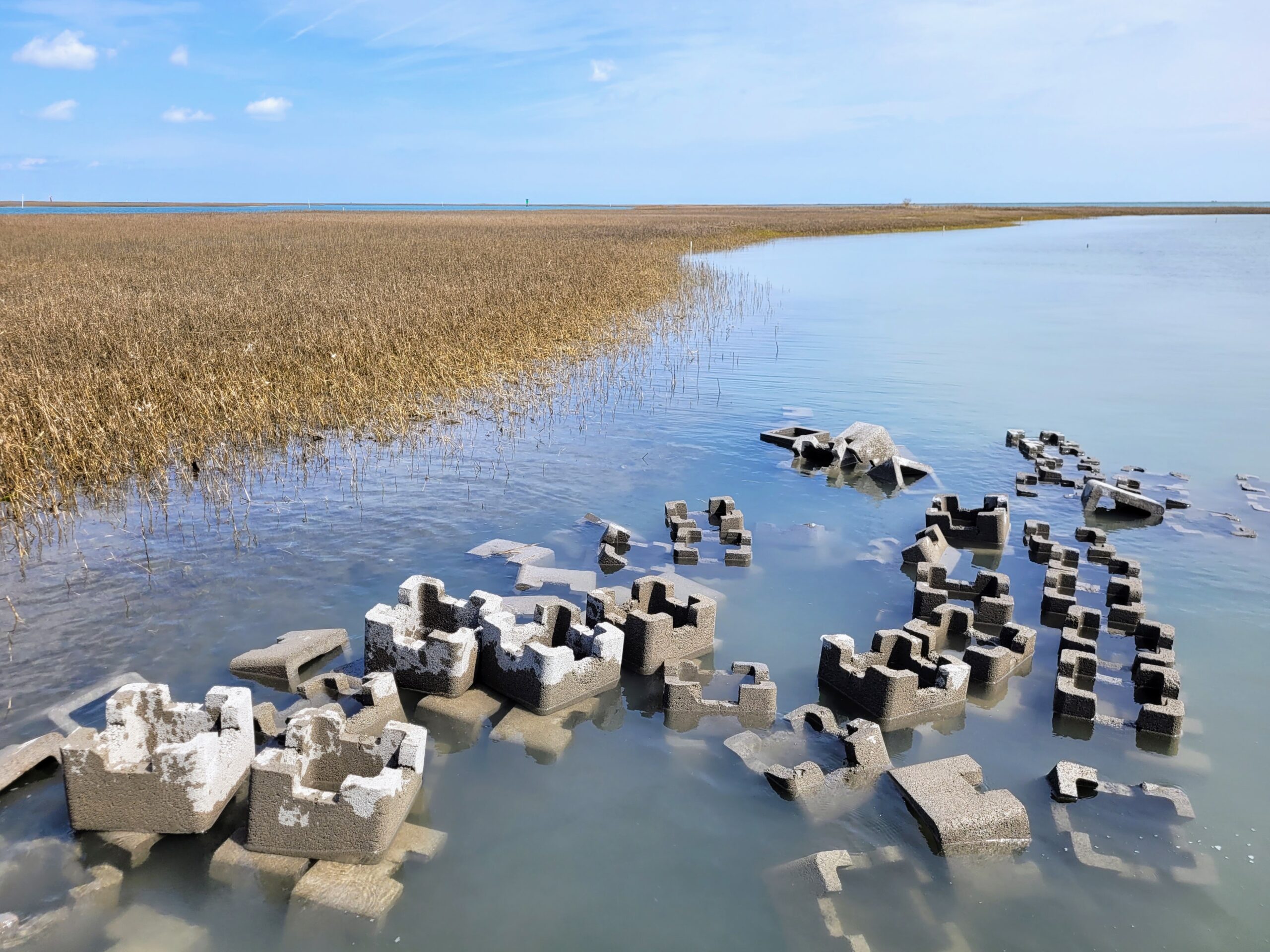The longest stretch of coastal wilderness along the eastern seaboard is found right here in coastal Virginia. The barrier islands of the Eastern shore stretch from the Maryland border on Assateague Island and continue for 70 miles to the south, all the way to Fisherman Island and the mouth of the Chesapeake Bay.
At the present moment, there are about 23 islands that make up this incredible stretch of coastline, but that number can change with time. Coastal storms, sea level rise, and ocean currents can shift the islands and the inlets around, making for a very dynamic, ever-changing landscape.
While different islands are owned and managed by different agencies, many of them fall under The Nature Conservancy. To learn more about each individual island and its corresponding management agency, check out this interactive map.
Over the last 15-20 years, some islands have experienced more change than others. Cedar Island, located close to the town of Wachapreague, has shifted so much in recent years that the inlet between Cedar and Parramore Islands is changing shape and widening over time. As the inlet widens, tidal currents shift, ultimately causing erosion to some of the inner marsh islands between the barrier islands and the mainland.
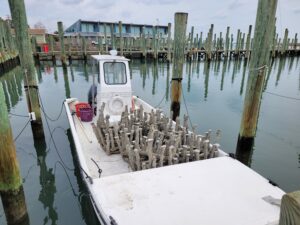 In an effort to slow the erosion of the marsh islands and protect the town of Wachapreague, The Nature Conservancy is stepping in. Staff and volunteers are working side by side, diligently working to build oyster reefs along the edges of the marsh which will help stabilize the marsh islands and mitigate some of the wave action coming in through the inlet. Oyster reefs are built by installing substrates that allow oyster spat to attach to and grow into a thriving reef.
In an effort to slow the erosion of the marsh islands and protect the town of Wachapreague, The Nature Conservancy is stepping in. Staff and volunteers are working side by side, diligently working to build oyster reefs along the edges of the marsh which will help stabilize the marsh islands and mitigate some of the wave action coming in through the inlet. Oyster reefs are built by installing substrates that allow oyster spat to attach to and grow into a thriving reef.
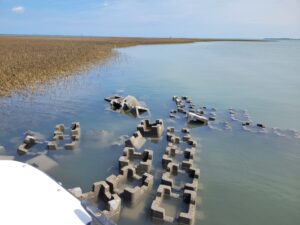 The Nature Conservancy is using two types of substrate for the oysters to grow on: oyster castles and oyster catchers. Oyster castles are essentially constructed with modified concrete blocks, purchased directly from a concrete manufacturer. Each block weighs about 30 lbs and must be unloaded from a truck to a boat by hand, and then unloaded from the boat to the marsh by hand. In just two hours, a team of staff and volunteers can transport over 200 concrete blocks to the marsh island. This must be done at high tide to allow the boats to get close enough to the spot in which the reef is being built. Then, at low tide, the team heads out again to stack the blocks and construct the actual castle reef.
The Nature Conservancy is using two types of substrate for the oysters to grow on: oyster castles and oyster catchers. Oyster castles are essentially constructed with modified concrete blocks, purchased directly from a concrete manufacturer. Each block weighs about 30 lbs and must be unloaded from a truck to a boat by hand, and then unloaded from the boat to the marsh by hand. In just two hours, a team of staff and volunteers can transport over 200 concrete blocks to the marsh island. This must be done at high tide to allow the boats to get close enough to the spot in which the reef is being built. Then, at low tide, the team heads out again to stack the blocks and construct the actual castle reef.
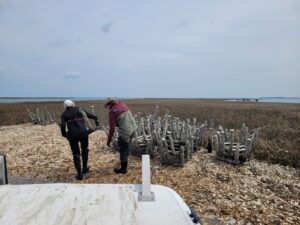 Oyster catchers look like little tables that are also placed on the edge of the marsh island to provide substrate for the oyster spat, but they actually have to be constructed by staff and volunteers before being deployed out on the island. Constructing the oyster catchers involves mixing concrete, rolling burlap through it, and forming into the table shape. Once the oyster catchers have had a chance to dry, they are transported to the island by boat at high tide. And just like the oyster castle blocks, the oyster catcher tables will be installed at low tide. Over the course of a few years, the oyster catcher tables will disintegrate, leaving only a natural oyster reef behind.
Oyster catchers look like little tables that are also placed on the edge of the marsh island to provide substrate for the oyster spat, but they actually have to be constructed by staff and volunteers before being deployed out on the island. Constructing the oyster catchers involves mixing concrete, rolling burlap through it, and forming into the table shape. Once the oyster catchers have had a chance to dry, they are transported to the island by boat at high tide. And just like the oyster castle blocks, the oyster catcher tables will be installed at low tide. Over the course of a few years, the oyster catcher tables will disintegrate, leaving only a natural oyster reef behind.
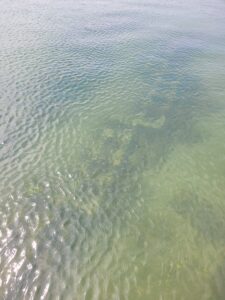 Paddling the water trails from Wachapreague is an opportunity that all paddlers should take advantage of when on the Eastern shore. Tidal currents can be strong though, so for inexperienced paddlers, it is recommended to hire an ecotour guide to take you out. The oyster reefs should be easy to spot at low tide, but at high tide, keep your eyes peeled – if you notice what looks like cinder blocks under water, that’s the artificial oyster reef!
Paddling the water trails from Wachapreague is an opportunity that all paddlers should take advantage of when on the Eastern shore. Tidal currents can be strong though, so for inexperienced paddlers, it is recommended to hire an ecotour guide to take you out. The oyster reefs should be easy to spot at low tide, but at high tide, keep your eyes peeled – if you notice what looks like cinder blocks under water, that’s the artificial oyster reef!
The Nature Conservancy is still looking for volunteers to help out for the 2023 season. Volunteer Coordinator Jennifer Dalke, can be reached at jdalke@tnc.org for more information. Jennifer will send out a detailed schedule where volunteers can select dates for different tasks – constructing, transporting, or installing either oyster catchers or oyster castles. If oyster reefs aren’t your thing, but you are still interested in volunteering, there will be plenty of other volunteer opportunities over the next few months.
To learn more about The Nature Conservancy’s oyster restoration efforts, click here. For more information on visiting Virginia’s barrier islands, check out Explore Our Seaside.
Happy water trails!
About the Author: Laura Scharle lives on the Eastern shore of Maryland and is a frequent paddler in coastal Virginia. She is a Virginia certified ecotour guide and is an independent marketing contractor with a focus in ecotourism and heritage tourism. Laura can be reached through our Eastern Shore ecotour guide listings.
